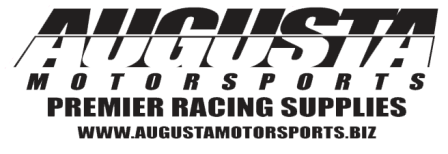Racing Belts Installation
Here at Augusta Motorsports we take driver safety very seriously. Each time we visit a track we find belts either out of date or not properly installed. We have attached a few Links and Pictures for your review. Special thanks to Simpson and Impact Safety
Here is a Great Information Page by Simpson.
Racing Belts Installation

1. Shoulder Belts: The optimum location for the shoulder belt anchor is level with the shoulder line. Anchor shoulder belts a MAXIMUM of 5 degrees below and 5 degrees above the shoulder line. When installing shoulder belts in conjunction with a head and neck restraint system the anchor point for the shoulder belt must be in accordance with the head and neck restraint system manufacturer's recommendations.
2. Lap Belt: Lap Belt anchors should be located in a position that is slightly wider than the seat allowing the webbing to pull in a straight line to the mounting anchors. Do not allow the webbing to come in contact with any sharp edges that could cause abrasion. The angle formed by the Lap Belt and the vehicle floor, when the belt is being worn, should be approximately 45 degrees.
3. Anti-submarine Belts: 5-way or 6-way anti-sub belt(s) should be anchored behind the extended Chest Line. The extended Chest Line is a line drawn from the chest to the Lap Belt buckle continuing to the floor. On 7-way systems the outside anti-sub belts wrap around the inner to under thigh and exit the bottom seat. Anchor in the same position as the Lap Belt.
4. Webbing Installation: see diagram for proper installation.
5. Anchor Installation: Anchor hardware must be installed at an angle that is compatible with the load direction of the webbing.
UNDER NO CIRCUMSTANCES ARE BOLTS INSTALLED THROUGH WEBBING ACCEPTABLE FOR INSTALLATION!!
Always use a Restraint Systems that are adjusted correctly. Users should NEVER run a loosely adjusted harness! Installed webbing lengths should be kept as short as possible for best performance.
To perform as designed, a Restraint System must be installed in strict compliance with the installation instructions. ANY deviation from approved installation may compromise the function, integrity and performance of the system.
All Belts (Shoulder, lap, Anti-Sub) must be installed to allow even tension across the entire width of the webbing. Any installation that bunches, crimps, bends, reduces the width or creates uneven tension across the webbing is unacceptable installation.
Particular attention must be made at mounting points, attachment points, and adjustment hardware to ensure symmetrical, even tension of the webbing when the user engages and tightens the system.
All components of a Restraint System should be inspected regularly and prior to every use, including the webbing, stitching, release mechanism, adjusters, and anchor points. Check the webbing for fraying, abrasion, nicks, cuts or other damage. Check all stitching for broken or damaged threads. All hardware should operates smoothly as new and should be free of deformation. A simple, "common-sense" inspection indicating a system, "Doesn't look right," means it is probably not. REMOVE THE SYSTEM FROM SERVICE IMMEDIATELY.
It is recommended that Restraint Systems be replaced at a minimum at least every two years. However, webbing that has been exposed to harmful solvents, chemicals, or acids, or prolonged exposure to outdoor elements, may need to be replaced sooner. A Restraint System that has been involved in an event such as a crash should also be replaced immediately. Consult your Sanctioning Body for their specific Restraint System requirements.
Always use Restraint Systems adjusted correctly and users should never run a loosely adjusted harness. Installed webbing lengths should be kept as short as possible for best performance.

